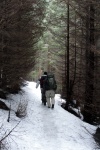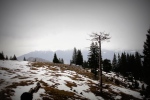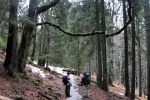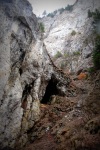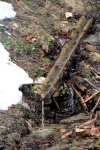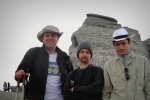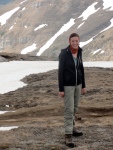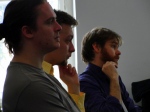I think one of the most amazing things about the Carpathian Mountain region is that it combines both the rolling hills of Appalachia and the rugged majesty of the Rockies. During these past two months, Anne and I were able to begin our exploration of the Piatra Craiului Mountains near the town of Zărnești and the Bucegi Mountains around the town of Bușteni. These first few day hikes will hopefully only be the prequel to some longer backpacking trips in the next few weeks.
We went to Piatra Craiului, or “Rock of the King” towards the end of March with our friend Kike from Spain. As folks can tell from the pictures, there was still a good bit of snow, and about half the day it rained a cold, icy rain. Wolves, bears and and lynxes all live in the mountains, however we only saw a fox during the day. Hopefully when we go back for several days, we will have more luck. Piatra Craiului is also home to a rare alpine flower, which sadly we were also not able to see, and will probably miss because it blooms in late July or August.
Piatra Craiului Mountains Gallery
- To the mountains!
- Lots of caves…
- Spring is coming
- Epic Anne
- Shepherds graze their sheep here
- Kike and I consulting under a beautiful branch
- Beautiful Troița on the trail
- Piatra Mica
- Piatra Mica
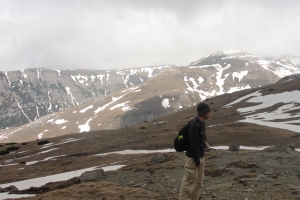 The Bucegi mountains are some of the highest peaks around Brașov. We often looked longingly at them from the train and finally by the beginning of May, the snow had melted enough to make the trails passable without snowshoes. We were extra fortunate to go with our friend Mihai from Brașov who knows the area well. His nephew Onu from Iași was also with us. There are several “natural attractions” in the Bucegi. One is a rock known as the “Spinx” and the other is the “Babele” or “Old Ladies.” Among the not-so-natural attractions is the “Hero’s Cross,” which is a WWI memorial and the cable car which transports people from the town of Bușteni to the sphinx and babele. We took the cable car to the sphinx due to time and made for Vârful Omu, the highest peak in the Bucegi at 2,505 meters (that’s 8,218 feet). Sadly, we ran out of time and Onu only had shorts and low-top hiking shoes. Even though it was May, it would not have been wise to go for Omul peak without good boots. Anne and I hop to make a 2-3 day hike in June from Sinaia to Bușteni.
The Bucegi mountains are some of the highest peaks around Brașov. We often looked longingly at them from the train and finally by the beginning of May, the snow had melted enough to make the trails passable without snowshoes. We were extra fortunate to go with our friend Mihai from Brașov who knows the area well. His nephew Onu from Iași was also with us. There are several “natural attractions” in the Bucegi. One is a rock known as the “Spinx” and the other is the “Babele” or “Old Ladies.” Among the not-so-natural attractions is the “Hero’s Cross,” which is a WWI memorial and the cable car which transports people from the town of Bușteni to the sphinx and babele. We took the cable car to the sphinx due to time and made for Vârful Omu, the highest peak in the Bucegi at 2,505 meters (that’s 8,218 feet). Sadly, we ran out of time and Onu only had shorts and low-top hiking shoes. Even though it was May, it would not have been wise to go for Omul peak without good boots. Anne and I hop to make a 2-3 day hike in June from Sinaia to Bușteni.
Bucegi Mountain Gallery
- In front of the “Sphinx”
- Left to right: Onu, me, Mihai
- “Babele”
- And the intrepid men set off into the wilderness…but where’s Annie?
- Mihai looks like a 1920s explorer
- Looking to Omul Peak
- Annie is preparing for takeoff…
- “Hey wait up”!
- Annie found a nice perch






